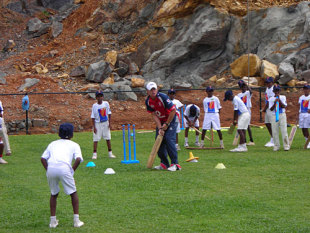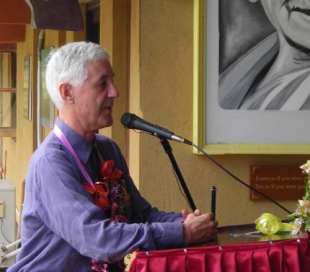
|

No kidding: it wasn't all hit and giggle for Ian Bell and Co. at the Spirit of Cricket programme
Andrew Miller
|
|
On Boxing Day 2004, the day when Sri Lanka was engulfed by tragedy on an apocalyptic scale, the country's cricketers were 7000 miles away in Auckland, contesting a one-day international against New Zealand that has long since faded to irrelevance. Not all of them were there, however. The most significant name on the team-sheet was halfway down the coast from Colombo to Galle, ruled out of the tour by his ongoing rehabilitation from shoulder surgery. It was an operation that came within 20 minutes of costing him his life.
Muttiah Muralitharan's destination that day had been the coastal village of Seenigama, not more than half an hour north of Galle. He was travelling at the invitation of his manager, Kushil Gunasekera - an elder of the village - to attend a cricket scholarship function at his charity initiative, the Foundation of Goodness. Murali was delayed in leaving Colombo and became snarled up in traffic as it beat a hasty retreat from the southern end of the island. "The sea was behaving strangely," he was told, and to his great disappointment - but later relief - he turned his car around and somehow kept ahead of the carnage as the coast was consumed in his wake.
In Seenigama, Murali's fellow function attendees were not so fortunate. Thirty children and their parents had already arrived at Gunasekera's family villa, which for seven years had been the headquarters of his foundation. Within minutes they were fleeing for
their lives as the waves swept in from the coast.
"On that fateful day, everything that we had created was shattered in a few minutes," said Gunasekera. Three of the children present were lost to the waters, a further busload of 50 were swept out to sea en route, and one in ten of the 1500 villagers was never seen again. "I had a good look at my villa for the last time as I ran, through the back roads," said
Gunasekera. "That day, what I saw in my village, I cannot describe in words."
The waves in Seenigama travelled up to two kilometres inland - aided by the illegal destruction of the local coral reef that could have provided a breakwater, and uninhibited by the low-lying marshland that made up much of the area. By the time they subsided, the region was a ruin and everything that Gunasekera had worked for had been destroyed.
The walls of his villa were still standing - albeit with a smear of floodwater near the ceiling, showing that the tide had peaked at around three metres - but everything else he was obliged to rebuild from scratch. He acquired himself a motto which has since been carved in stone on the gateposts of his villa: "The waves of compassion overpowered the waves of destruction."
*****

|

Mike Brearley: the MCC has provided inputs into the community that go beyond the ground it has sponsored
Andrew Miller
|
|
It is coming up for the third anniversary of the tragedy, but Seenigama is a neighbourhood transformed. Murali's passion, zeal and profile have set in motion the reconstruction of 1000 demolished houses, while Ian Botham and the rock star Bryan Adams are two other improbably connected celebrities who have adopted the cause as their own.
Today, though, it is all about the MCC, the oldest and most famous cricket club of all, which came to hear of the plight of the village, and whose patronage has taken Gunasekera's dream and sent it stratospheric.
The MCC bigwigs are out in force today, to celebrate the culmination of a two-year partnership. Mike Brearley, the president; Keith Bradshaw, the chief executive; John Stephenson, the head of cricket; and Roger Knight, the former secretary, are all in attendance as Gunasekera leads the party through the various and varied phases of
his grand project. A craft centre, an English language school, a fully equipped computer centre, and a lively kindergarten for the children too young to recall the horrors that befell their elders. All are fully funded and fully operational, and joyfully received by the
local community.
"The MCC has not merely provided a cricket ground and pavilion but a much broader input into the community," said Brearley. "And what is more, money and goodwill tends to attract more money and goodwill."
The Centre of Excellence, as Gunasekera's villa will henceforth be known, is just one part of the MCC's project, however. Ten minutes down the road in nearby Hikkuduwa, there is a more conventional mark of the club's patronage, as the Sri Sumangela Central College marks the opening of its new cricket ground.
Hikkaduwa is one of the most popular coastal resorts in Sri Lanka, a mecca for surfers and sun-seekers alike. It's also the location for a devastatingly poignant memorial to the tsunami - the remains of a train that was plucked off the railway line from Colombo to Galle by the waves, killing all 1600 people on board. Three battered carriages have been salvaged from the debris and repositioned in a siding next to the level crossing by the station, fully in view of the MCC convoy as it makes its way to the day's second venue.
Much like the Asgiriya Stadium in Kandy and Surrey's Cricket Village near Colombo, the MCC-sponsored ground has been carved directly out of the jungle, creating a wonderfully atmospheric amphitheatre. Reddish-brown scars on all sides of the pitch bear testament to the newness of the venue, but also provide perfect natural viewing platforms for the locals who've come to see the show. Later in the day the ground will be officially opened by a Twenty20 match between the MCC and the Foundation of Goodness, but the first item on the agenda is a Spirit of Cricket skills programme for a group of Under-11 cricketers.

|

The remains of the train that was struck by the tsunami, now preserved as a memorial at Hikkaduwa
Andrew Miller
|
|
Ian Bell and Graeme Swann have come along for this stage of the day, which is billed as a chance for the children of the local community to get an introduction to the game. Not one of them needs it, however. Bell and his various batting partners are run out by direct hits every other delivery, while Swann has a mow at his first ball and loses all three stumps. The pair are seriously impressed by what they see, particularly when an outstanding one-handed catch is pulled off in the deep.
Hardly a chance goes to ground all day, and by the end of it all, both professionals have ditched the kid gloves and are spanking their shots and tweaking their offbreaks as hard as possible. England's half-hearted Kwik-cricketers, the likes of whom turn out at Lord's
during Test match lunch-breaks, have been comprehensively put to shame. Later in the day, in his opening address, Brearley speaks of his desire for the next Murali or Mahela Jayawardene to come from the playing fields of Sri Sumangela, but on this evidence, the MCC has just mined an entire generation.
By early afternoon the ground is awash with villagers - some 3000 people crowd around the various vantage points, some perched high on the rocks next to the new bacon-and-egg-coloured indoor school, others sat peacefully on the boundary's edge or in the shade of the pavilion. It is no exaggeration to suggest that the MCC's 20-over game is watched by more people than turned out for each day of the Kandy Test match, Murali's world record notwithstanding.
Clearly the admission costs were a factor during the Test, but there is something else at play here. A pair of pundits belt out the action over the giant PA, trumpeters and drummers keep up their own musical commentary as they cavort on the boundary's edge, and free wafers and orange juice are passed among the parched spectators. At the break
between innings, just as the evening rain begins to fall, a troupe of brightly coloured girls takes to the outfield to perform traditional Sri Lankan dances. After the shattering events of the tsunami, the sense of a community being rebuilt is unmistakeable.
"It's difficult to know what the end result will be when you commit to a project such as this," said Brearley, "but it's only when you come here that you get to see something that's alive and real." Gunasekera is the happiest man alive as he leads his team out to bat, and when a spanking innings is ended by Bradshaw's sharp catch in the gully, he departs the field with a grin as broad as the spectrum of projects his efforts have helped put in place. In one small corner of tsunami-ravaged Sri Lanka, the waves of compassion really have overpowered the waves of destruction.
Andrew Miller is UK editor of Cricinfo


